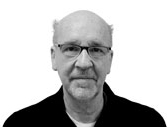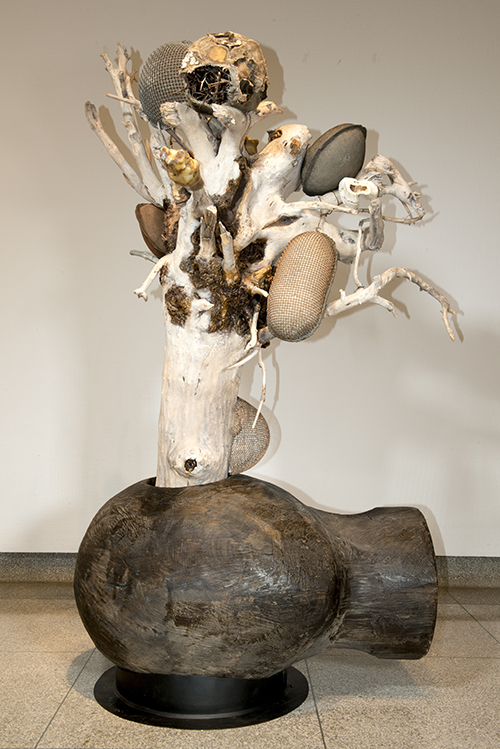
PAUL KRAINAK

Thomas Skomski, “Uproot – Locura” (PHOTO BY DANNYL DOLDER)
In fact, Skomski’s newest work was produced during a recent health and environmental emergency with which the artist and his wife continue to struggle. The Community Word editor Clare Howard published a cover story on their circumstances in January 2018. Skomski was also a subject of a Swedish documentary, “The New Gold,” which covered environmental degradation caused by silica mines near his home in LaSalle County, Ill.
That and the comprehensive survey of one’s artwork, i.e. taking stock of a life and placing it in the care of a benevolent institution well suits the “Urgent Care” metaphor. Skomski’s aggregate work also underscores symptomatically the remarkable, sometimes impermeable work and transformation that his oeuvre has taken over time. The artist’s ability to bite off a kind of meditation on form, to make immediacy and presence a cornerstone of his practice, is radical and pleasurable. Here is almost 50 years of deftly calibrated, meta-votive labor.
Critics have noted that the subject of Tom Skomski’s sculpture vacillates routinely between mind and body. Few artists have woven the fiber of subjectivity as a state of in-betweeness so convincingly. His survey includes sculpture, photography, video, drawing and other media hybrids that steadily drive this home. Works are rigorously structured by the degree they designate form –– not by how they imitate reality but contextually as color, contour, surface, heft, volume –– their thingness. That emphatic measurable quality of the real is what’s so persuasive even if the artist’s aptitude for craft and materials doubles as a platform for the auratic.
A standout work “Uproot – Locura” encompasses much of the artist’s concern with physical turbulence, decay and rebirth. Constructed from the inverted stump of a cottonwood tree, barely recognizable fruit of copper, bronze and steel found objects adorn the gnarled antennae. A large blackened head serves as its base. Essentially an exotic ruin remnant, the assemblage has connotations of self-portraiture, the sleeping artist with an assortment of troubling dreams aflame in the ether. The allusion to antiquity is relevant as art historical texts often present nature as subservient to humans and the gods, but Skomski turns the tables on Elysian mythology. In reliquary-like assemblages that meld dated technology and natural decay, he conjures anti-form and curious un-monuments to fate. “Uproot – Locura” is peculiarly beautiful and mournful. It understates Freud’s description of the unheimlich (or uncanny) – that which is at once familiar and alien.
Skomski’s observation about the space we inhabit between birth and death is discomforting on one hand. But likening one’s life as a “stage” suggests other intervals before or after, or in other states –– conscious or unconscious. Since spans of life begin and end continually, re-addressing his immediate surroundings seems, well organic. Skomski walks his acreage as flaneur, inspector and narrator, collecting evidence and ritualizing it with inevitably complex constructions. Shading his work with traces of the garden, as well as the necropolis, brings mortality into exquisite focus.
While there have always been artists who have plumbed nature as a subject, few I can think of have attempted to engage waste and naturally degraded parts of the rural environment as a worthy subject for contemplation. Skomski’s work is methodically physical, sometimes gleaming, frequently abstract and intermittently metaphoric.
Fewer studio artists have a clearer understanding of what surrealism might look like in a world where fantasy and spectacle have subsumed visual production and popular culture. Skomski’s reckoning of the rural – raw and cooked, activate his practice and skirt ordinary notions about beauty, criticality and spirituality. His exploration into our occasionally paralyzing human experience, as expressed in the title of the show, confirms that art can be restorative even if precarious.
The Skomski exhibition runs until September 29.

5 comments for “Inland Art | Thomas Skomski exhibit”
Recent Comments
Paul, Your response to the work is stunningly insightful.Brilliant. It is so good that you have raised the bar for future work. Thank you!
Thanks for this masterfully written review that casts a large net and captures the essence and sweep of this 50 year survey.
I have known and deeply admired Tom’s work for many years. His artistic products are unfailingly spiritual, marked by spectacular attention to detail, ask the most thought provoking questions about our existences and our inevitable decay. However, there is a thread of humor which always seems to be present, no matter how intense the work appears.
Thanks so much Rick. Hope all is good with you.
Tom
“Urgent Care: Stuck in that Awkward Space Between Birth and Death”